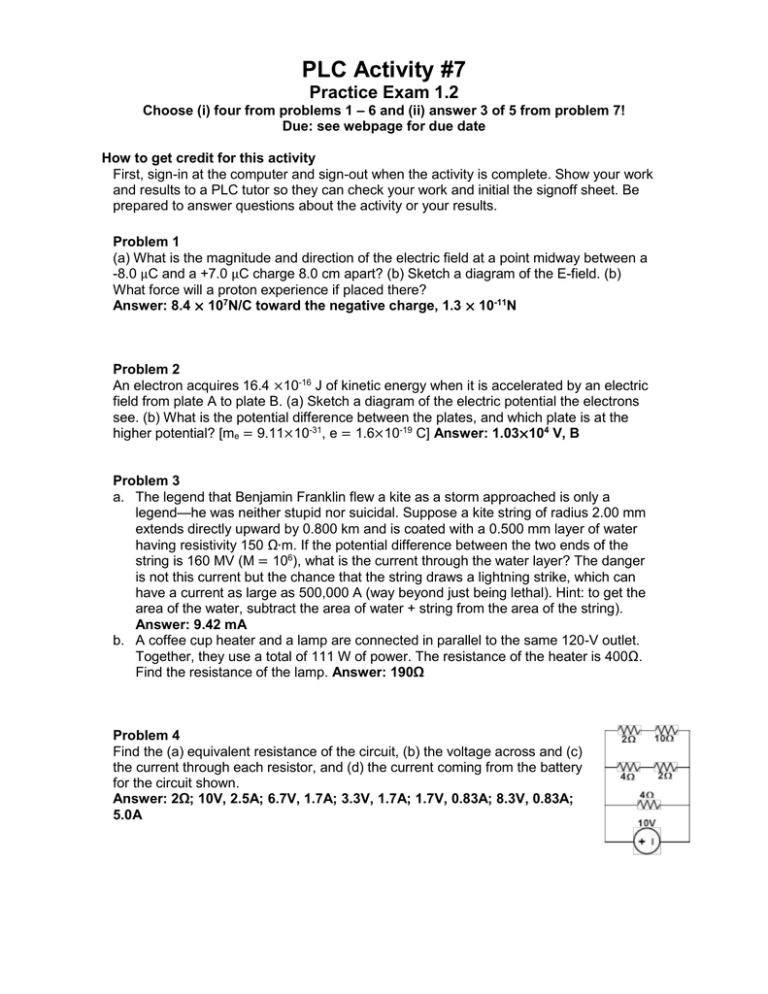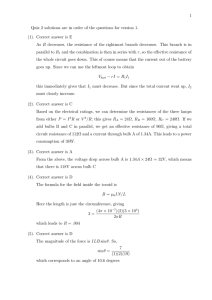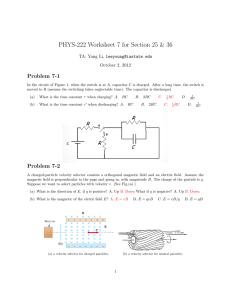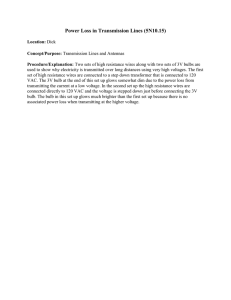PLC Activity #7 Practice Exam 1.2
advertisement

PLC Activity #7 Practice Exam 1.2 Choose (i) four from problems 1 – 6 and (ii) answer 3 of 5 from problem 7! Due: see webpage for due date How to get credit for this activity First, sign-in at the computer and sign-out when the activity is complete. Show your work and results to a PLC tutor so they can check your work and initial the signoff sheet. Be prepared to answer questions about the activity or your results. Problem 1 (a) What is the magnitude and direction of the electric field at a point midway between a -8.0 μC and a +7.0 μC charge 8.0 cm apart? (b) Sketch a diagram of the E-field. (b) What force will a proton experience if placed there? Answer: 8.4 × 107N/C toward the negative charge, 1.3 × 10-11N Problem 2 An electron acquires 16.4 ×10-16 J of kinetic energy when it is accelerated by an electric field from plate A to plate B. (a) Sketch a diagram of the electric potential the electrons see. (b) What is the potential difference between the plates, and which plate is at the higher potential? [me = 9.11×10-31, e = 1.6×10-19 C] Answer: 1.03×104 V, B Problem 3 a. The legend that Benjamin Franklin flew a kite as a storm approached is only a legend—he was neither stupid nor suicidal. Suppose a kite string of radius 2.00 mm extends directly upward by 0.800 km and is coated with a 0.500 mm layer of water having resistivity 150 Ω∙m. If the potential difference between the two ends of the string is 160 MV (M = 106), what is the current through the water layer? The danger is not this current but the chance that the string draws a lightning strike, which can have a current as large as 500,000 A (way beyond just being lethal). Hint: to get the area of the water, subtract the area of water + string from the area of the string). Answer: 9.42 mA b. A coffee cup heater and a lamp are connected in parallel to the same 120-V outlet. Together, they use a total of 111 W of power. The resistance of the heater is 400Ω. Find the resistance of the lamp. Answer: 190Ω Problem 4 Find the (a) equivalent resistance of the circuit, (b) the voltage across and (c) the current through each resistor, and (d) the current coming from the battery for the circuit shown. Answer: 2Ω; 10V, 2.5A; 6.7V, 1.7A; 3.3V, 1.7A; 1.7V, 0.83A; 8.3V, 0.83A; 5.0A Problem 5 a. A charge of −8.3 μC is traveling at a speed of 7.4 × 106 m/s in a region of space where there is a magnetic field that lies along the x-direction. The angle between the velocity of the charge and the field is 52o. A force of magnitude 5.4 × 10-3 N acts on the charge. (i) Sketch the trajectory of the charge in the magnetic field. (ii) Draw a diagram of the RHR that explicitly shows the directions of v, B and FB. (iii) What is the magnitude of the magnetic field? Answer: 1.1 × 10-4 T b. Particle X of −2.3 μC and mass 3.38 × 10-12 kg moves through a velocity selector at a constant speed in a straight line. The electric field of the velocity selector is 3.80 × 103 N/C, while the magnetic field is 0.360 T. (i) What is the speed of particle X when it exits the velocity selector? (ii) When the electric field is turned off, particle X moves on a circular path. Determine the radius of the path? Answer: 11,000 m/s, 44.9 nm Problem 6 A 100-turn, 2.0-cm-diamcter coil is at rest in a horizontal plane. A uniform magnetic field 60° away from vertical increases from 0.50 T to 1.50 T in 0.60 s. (a) Draw a picture of the situation that indicates Bind, iind and ℇind. (b) What is the induced emf in the coil? Answer: 26 mV Problem 7 Use short concise sentences to answer 3 of the 5 following questions using physics principles. Make sure to explain your reasoning for each answer a. Over time, atoms “boil off” the hot filament in an incandescent bulb and the filament becomes thinner. How does this affect the brightness of the lightbulb? b. Lightbulbs are typically rated by their power dissipation when operated at a given voltage. Rank the following lightbulbs from smallest to largest resistance when operated at the voltage for which it's rated? (i) 0.8 W, 1.5V, (ii) 6W, 3V, (iii) 4W, 4.5V, and (iv) 8W, 6V. c. In the circuit shown, four identical bulbs are connected to a flashlight battery. How do the brightness’s of the bulbs compare? Which light bulb has the greatest current passing though it? Which light bulb has the greatest voltage? What happens if bulb A is unscrewed? Bulb B? Bulb C? Bulb D? d. If an electron is not moving, is it possible to set it in motion using a magnetic field? Explain? e. A proton is moving near a long, current-carrying wire. (i) When the proton is at the point (A), in which direction is the force on it? (ii) Point B?




